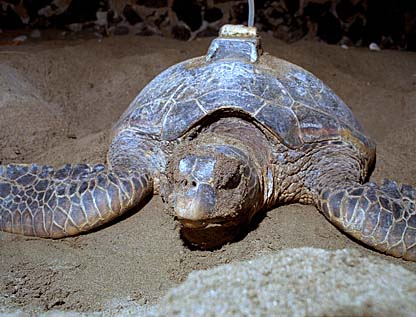
The green sea turtle known as "Maui Girl" nests near Lahaina in 2002. The turtle has returned to beaches near Lahaina three times so far this year. Maui Girl was among dozens of wild-born turtles tagged and released at 1 year old in 1981 and is the first to have been recaptured and identified after laying eggs.
Familiar turtle
back on MauiThe green sea turtle dubbed
"Maui Girl" became known
for her prolific nesting activity
"Maui Girl" is back for her third season nesting on Lahaina beaches.
The 24-year-old green sea turtle is something of a celebrity among Lahaina residents and visitors for her prolific nesting activity in 2000 and 2002.
And she has a special place in the heart of George Balazs, leader of the Hawaii Marine Turtle Research Program, who released her as a yearling in 1981 off Hilo.
Maui Girl was among dozens of wild-born turtles raised to a year old at Oahu's Sea Life Park. They were then tagged and released. She is the only one that has been re-identified, thanks to a metal tag with the number "5690" that amazingly stayed attached to her right front flipper until just this year.
"I have fond memories of setting her free ... when she was just a yearling, a bit larger than the size of my hand and weighing only a few pounds," Balazs wrote to fellow scientists in an e-mail after he tracked her by satellite transmitter between July 2002 and April 2003.
"This is one of the most exciting, successful and rewarding sea turtle satellite trackings I've ever been involved in," Balazs said in 2003 after tracking Maui Girl's whereabouts along the West Maui Coast.
Balazs said that after the turtle completes three or four nesting cycles this year, she will be outfitted with a new, smaller satellite transmitter.
In the summer of 2002, Maui Girl laid seven nests of eggs in Lahaina, twice as many as the average female lays in a typical season. This summer, she was first spotted May 8, and again May 21 and 22.
From a yearling that weighed 6 or 7 pounds in 1981, Maui Girl has grown to a shell size of more than 3 feet and an estimated weight of 200 pounds.
Though green sea turtles are year-round residents of the main Hawaiian Islands, no more than a handful nest here. Most nest every other year in the remote Northwestern Hawaiian Islands.
The turtles spend the majority of their time in the ocean, but mature females emerge onto sandy beaches on summer nights to lay one or more clutches of about 100 eggs. The eggs hatch about two months later, and the hatchlings have to make their own way to the ocean.
Saichi "Saik" Sasaki, 83, is just one of Maui Girl's many local admirers.
"Two weeks ago it came the first night (this year)," Sasaki said last Tuesday. "The dogs barked, so we went to see and the turtle was on the lawn."
However, instead of nesting adjacent to Sasaki's beachfront home, as she had in years past, Maui Girl chose a spot a couple of houses down from the nearby Lahaina Shore Hotel.
Sasaki helped state wildlife official Skippy Hau mark the nest so people will not accidentally trample it during its incubation period.
Once it is marked, Sasaki said the entire neighborhood, and even visitors, look out for a nest's welfare.
"People seem to understand and leave it alone," he said.
"I've lived here more than 50 years," Sasaki said. "All the years, we didn't have any (turtles nesting). It's funny to see that when they finally arrive, now it's pretty steady."
Balazs' research over three decades has shown that the population of green sea turtles in the Hawaiian Islands is increasing.
Sasaki hopes there will be a hatching of turtles when his grandchildren visit in July.
The hatchlings, which weigh just a few ounces, leave "track marks all down the beach," he said.
"They take off for the ocean -- they know where the sea is. It's very nice."
Green sea turtles are a threatened species in Hawaii and protected by state and federal laws.
A person found guilty of purposefully injuring a green sea turtle could face fines of up to $5,000 per violation and administrative fees up to $10,000.
If you think you see a turtle nesting on any island beach at night, do not disturb it, but do take note of the nest location and report it to Balazs on Oahu at 983-5733 or gbalazs@honlab.nmfs.hawaii.edu.
